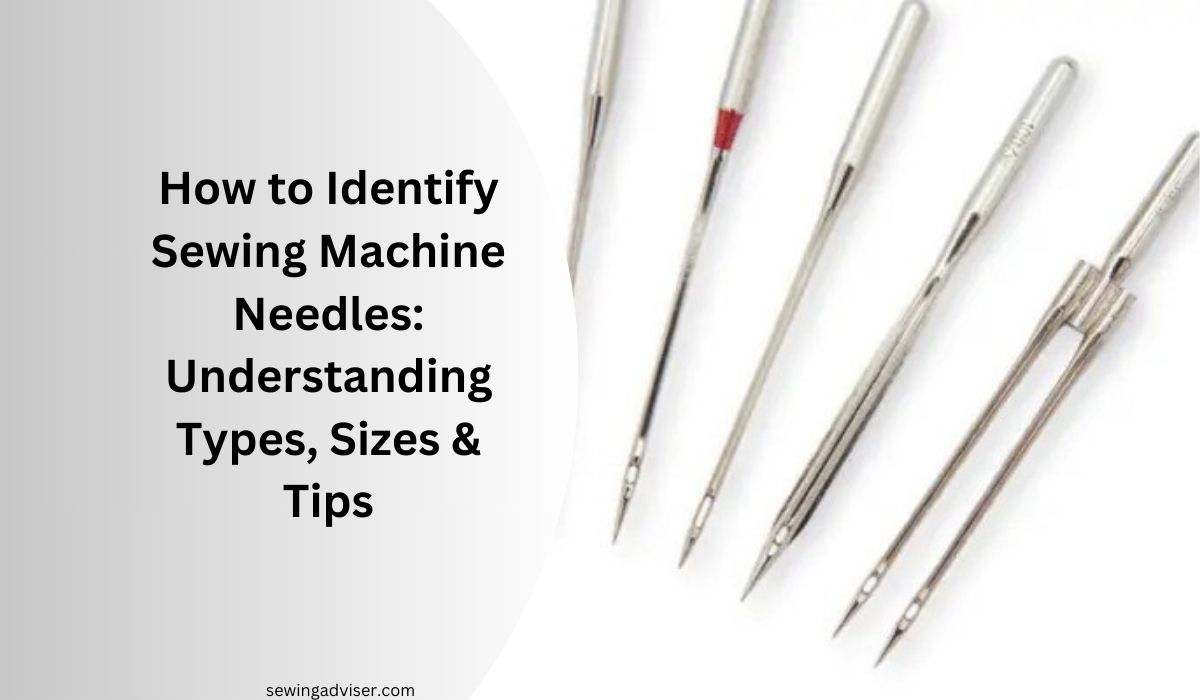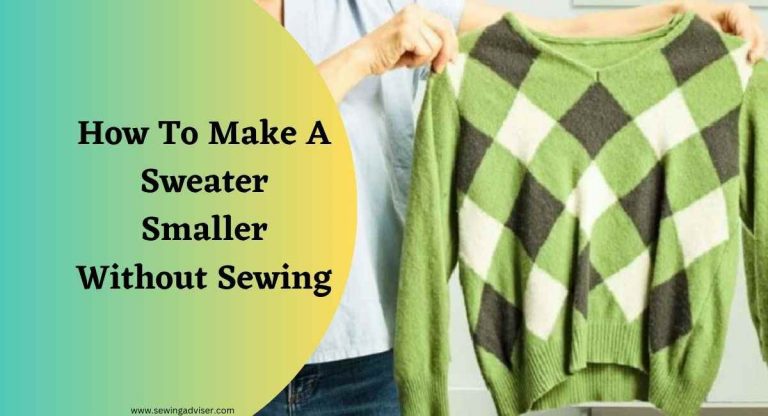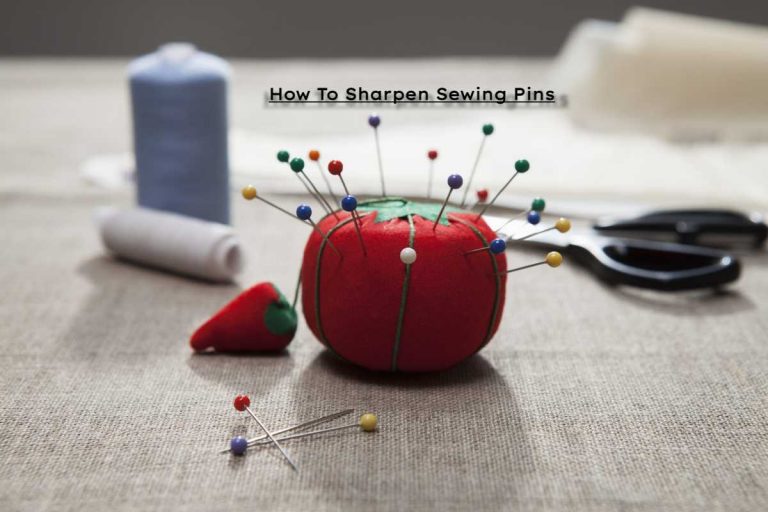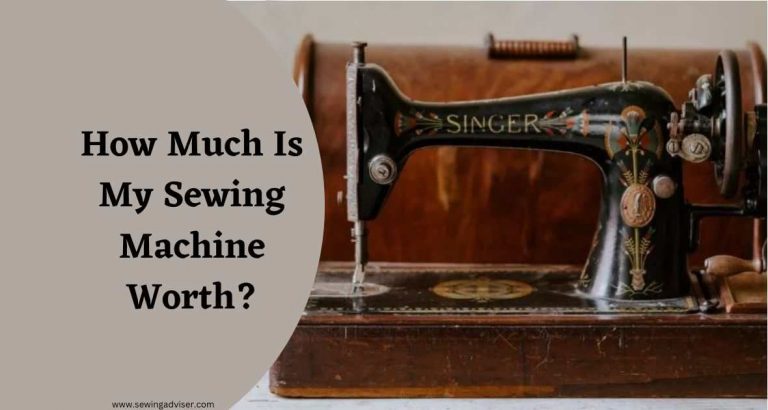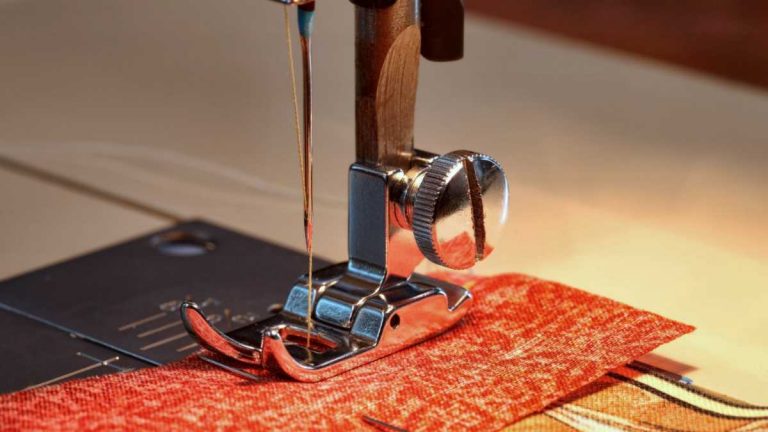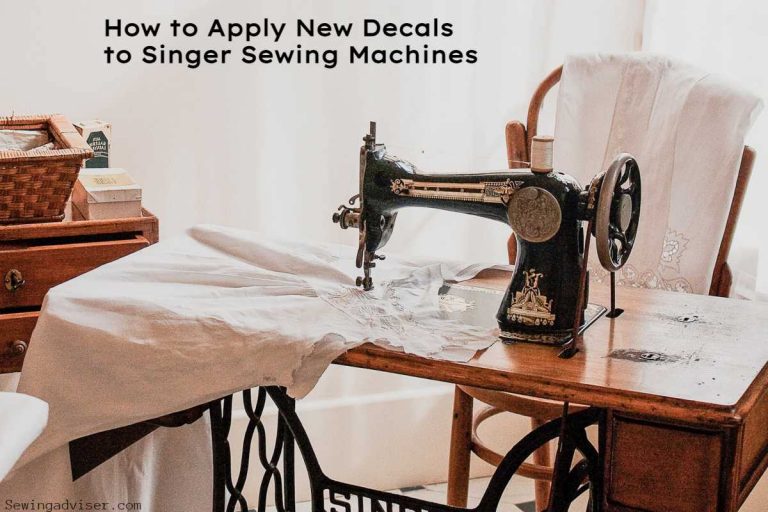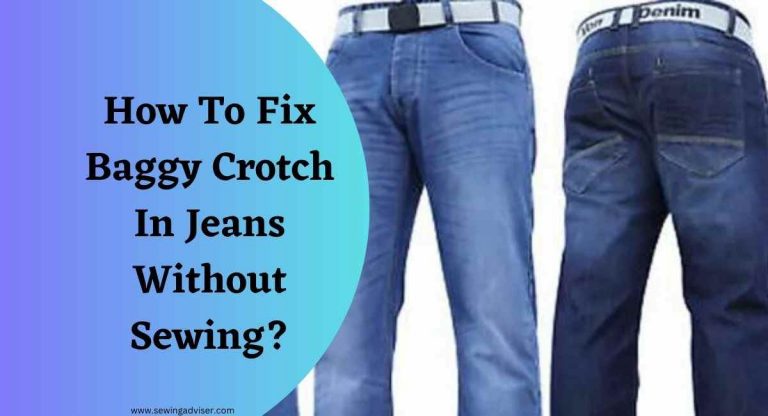How to Identify Sewing Machine Needles: 2024 Complete Guide
Did you know that using the wrong sewing machine needle can result in broken threads, skipped stitches, or even damage to your fabric?
Understanding the different types of sewing machine needles and how to identify sewing machine needles is crucial for achieving successful stitching outcomes.
Whether you’re a beginner or an experienced sewist, mastering this skill will elevate your sewing projects to new heights.
Understanding the anatomy of a needle, deciphering needle sizes, recognizing various needle types, and understanding the system are key components of becoming proficient in identifying sewing machine needles.
We’ll unravel these concepts, providing you with practical insights and examples along the way.
Get ready to boost your confidence at the sewing machine as we demystify the art of distinguishing between different sewing machine needles.
See Also: How to change a Sewing Machine Needle
Key Takeaways
- Understanding sewing needle codes is essential for choosing the right needle for your sewing project.
- Different types of sewing machine needles cater to specific fabric and thread combinations, so it’s crucial to match the needle type to your project.
- Specialty sewing machine needles, such as quilting or embroidery needles, can enhance the quality of your work for specialized projects.
- Identifying needle sizes based on their numbers and corresponding fabric weights ensures optimal stitching results.
- Selecting the right needle involves considering factors like fabric type, thread type, and the sewing technique you plan to use.
- Properly inserting sewing machine needles and regularly maintaining them can prevent stitching issues and prolong the life of your needles.
See Also: Can you bring Sewing Needle on a Plane
Understanding Sewing Needle Codes
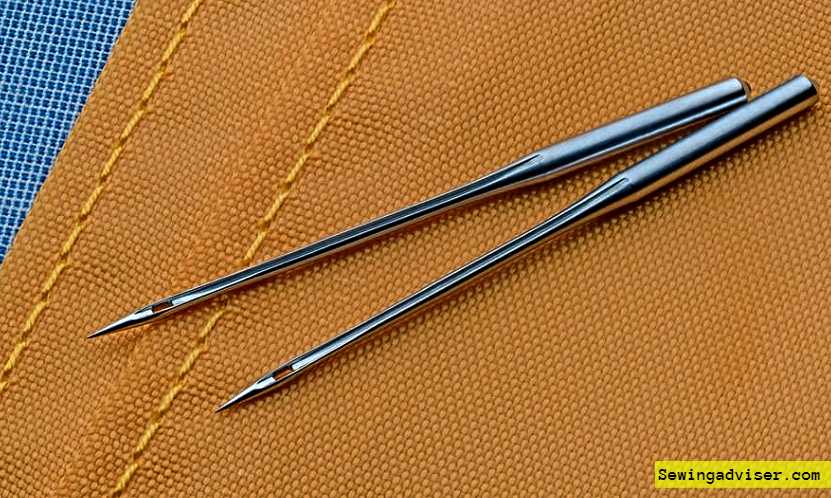
Color Code Chart
Sewing machine needles come with a helpful color-coded system that simplifies the process of identifying the right needle for specific sewing tasks. For instance, universal needles are often color-coded in blue, while ballpoint needles may be green.
By referring to a color code chart, such as one provided by the manufacturer or found online, you can quickly match the color on the needle’s shank to its designated fabric or project type. This ensures that you’re using the correct needle for different fabrics, such as cotton, denim, or knit.
Understanding and utilizing this color code chart is essential because it prevents issues like skipped stitches or fabric damage caused by using an incompatible needle. It also streamlines your sewing process by eliminating trial and error when selecting needles for various projects.
Number System
In addition to color codes, sewing machine needles are categorized based on a numbering system that indicates their size, type, and style.
Each number corresponds to a specific needle size and type smaller numbers indicate finer needles suitable for lightweight fabrics, while larger numbers represent heavier ones designed for thicker materials like denim or canvas.
Familiarizing yourself with this number system is crucial because it allows you to select the appropriate needle size for different fabrics and threads used in your sewing projects.
For example, if you’re working with delicate silk fabric, choosing a smaller numbered needle will help prevent snags and runs in the material.
On the other hand, heavy-duty projects like upholstery require larger numbered needles capable of penetrating dense materials without breaking.
Also Read: Sewing Machine Thread Breaking at Needle: Causes & Solutions
Needle Systems
Various needle systems are available to fit different types of sewing machines domestic machines typically use 130/705H (also known as 15×1) needles while industrial machines may require specific systems like 135×5 or DBx1.
Understanding these systems is crucial because it ensures compatibility between your machine and the chosen needle type.
Different activities such as quilting or embroidery might call for specialized needle systems tailored to those particular needs for instance, quilting requires precision stitching through multiple layers of fabric which can be achieved using quilting-specific needles designed with tapered points.
Read Also: How to Change Needle on Brother Sewing Machine Quickly
Needle Points
The points of sewing machine needles vary depending on their intended application the sharp point variety works well with woven fabrics such as cotton or linen due to its ability to pierce through tightly woven fibers without causing damage. On contrast,ballpoint
Types of Sewing Machine Needles
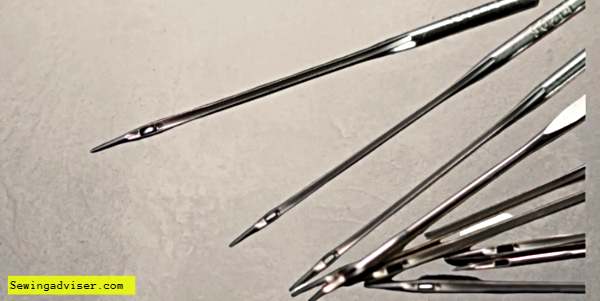
Important Note: Discover The Value – How Much Is My Sewing Machine Worth?
Universal Needles
Universal needles are perfect for general sewing tasks. They are incredibly versatile and can be used with various fabric types, making them convenient for everyday sewing projects.
Whether you’re a beginner or an experienced sewer, universal needles offer flexibility and ease of use. Their ability to work well with different fabrics and regular point needle makes them a go-to choice for many sewers.
These needles come in handy when working on a wide range of projects such as garments, quilts, or home decor items.
For instance, if you’re stitching together a cotton blouse one day and hemming a pair of linen pants the next day, universal needles will seamlessly handle both tasks without needing to change the needle.
Stretch Needles
Stretch needles are specifically designed to tackle stretchy or elastic fabrics like jersey knits and spandex. These specialized needles prevent skipped stitches and fabric puckering that often occur when working with stretch materials.
By using stretch needles, you can achieve professional-looking results on knitwear without any hassle.
When sewing activewear, swimwear, or other stretchy garments, these needles ensure that the fabric retains its elasticity while also maintaining strong seams.
This is particularly important as regular universal or sharp-pointed needles may cause snags in delicate knit fabrics.
Denim Needles
Denim needles are equipped with a strong and sharp point that easily penetrates heavy materials such as denim or canvas.
The design of these specialized needles ensures they can withstand the rigors of dense fabrics while offering durability and precision during stitching.
If you’ve ever struggled to sew through layers of denim using regular sewing machine needles, switching to denim-specific ones will make your task much easier.
With their sturdy construction and reinforced shafts, these needles prevent breakage even when dealing with multiple layers of tough material.
Leather Needles
Leather needles feature a wedge-shaped point that effortlessly pierces through leather and suede without causing damage to the material itself.
Crafted specifically for handling tough materials like genuine leather or faux leather, these specialized needles provide clean stitching along with professional-quality results.
Whether you’re creating leather accessories such as bags or wallets at home or repairing leather clothing items professionally, utilizing dedicated leather **needless ensures your stitches remain neat while preserving the integrity of the material.
Read Also: Best Multi Needle Embroidery Machines
Specialty Sewing Machine Needles
Embroidery Needles
Embroidery needles are designed with a larger eye to accommodate decorative threads and prevent shredding. These needles are perfect for intricate embroidery work, ensuring precise and flawless stitching.
By using embroidery needles, you can enhance the overall appearance of your embroidered designs on various fabrics.
For example, when working with delicate metallic or specialty threads for embellishments, using embroidery needles ensures that the threads remain intact without any breakage or damage.
Using standard sewing machine needles for embroidery work may result in thread breakage or uneven stitches due to the fine nature of decorative threads.
However, by switching to embroidery needles, you can avoid these issues and achieve professional-looking results every time.
Metallic Needles
Metallic needles feature a larger, elongated eye specifically designed to prevent metallic threads from breaking or shredding during stitching.
When working with metallic or specialty threads such as gold or silver metallic yarns, using standard sewing machine needles might lead to thread damage and poor stitch quality.
However, by utilizing metallic needles, you can preserve the integrity of delicate metallic threads while achieving stunning embellishments on your projects.
The unique design of metallic needles ensures smooth embroidery and decorative stitching without compromising the quality of your materials.
Whether you’re creating intricate patterns with metallic threads for quilting projects or adding decorative touches to garments, using specialized metallic needles is essential for achieving professional-looking results.
Read Also: Best Sewing Machines For Heavy Fabrics
Identifying Needle Sizes
Comparing Sizes
Needle sizes vary based on the thickness of the fabric and thread. Understanding this is crucial for achieving professional results.
For instance, when working with lightweight fabrics like chiffon or organza, a smaller needle size such as 9/70 or 11/75 would be suitable to prevent damage to the delicate material.
Conversely, heavier fabrics like denim or upholstery require larger needles such as 16/100 or 18/110 to penetrate the dense fibers effectively.
Comparing sizes also helps in selecting the most suitable needle size for specific sewing projects.
If you’re quilting with multiple layers of fabric and batting, using a larger needle like an 14/90 or 16/100 can prevent skipped stitches and ensure that the needle doesn’t bend or break due to excessive strain.
Thicknesses
Understanding how different needle thicknesses correspond to various fabric weights and densities is essential for preventing issues during sewing.
For example, when working with light to medium-weight woven fabrics such as cotton poplin or linen, using a universal needle in size 12/80 ensures proper stitch formation without causing puckering.
On the other hand, if you’re sewing heavyweight materials like canvas or duck cloth, opting for a larger-sized needle such as an 18/110 prevents potential fabric distortion and allows smooth stitching through multiple layers.
Matching the appropriate needle thickness to your specific project not only enhances stitch quality but also prolongs your machine’s lifespan by reducing wear caused by improper needles.
Selecting the Right Needle
Needle for Threads
Selecting the right needle for specific thread types is crucial for achieving optimal stitch quality. Different thread materials require compatible needle types to prevent issues like breakage or tension problems.
For instance, using a heavy-duty needle with delicate threads can lead to snagging and tearing of the fabric. Conversely, using a fine needle with thick threads might cause skipped stitches or uneven tension.
Choosing the appropriate needle for threads contributes to seamless stitching and overall project success. This means that when working with specialty threads such as metallic or elastic, it’s essential to use needles designed specifically for those materials.
By matching the correct needle to the thread type, sewers can avoid frustration and ensure that their projects turn out beautifully.
Fabric Considerations
Fabric considerations play a vital role in determining the appropriate needle type and size for sewing projects. Understanding how different fabrics interact with various needles is key in achieving professional-looking results.
For example, sewing on denim requires a sturdier needle compared to working on silk or chiffon due to differences in fabric thickness and density.
Considering fabric characteristics guides in selecting the most suitable needle to ensure smooth sewing experiences. When handling stretchy fabrics like spandex or knits, ballpoint needles are preferable as they gently push through the fibers without causing snags or runs.
On the other hand, sharp needles are better suited for woven cottons and linens because they effortlessly pierce through these materials without damaging them.
Inserting Sewing Machine Needles
Correct Insertion
Proper insertion of sewing machine needles into the sewing machine is crucial for safe and effective stitching. Incorrectly inserted needles can lead to stitching problems, machine malfunctions, or potential accidents during sewing. Ensuring correct insertion of needles optimizes stitch quality and overall sewing performance.
When inserting a machine needle, it’s important to ensure that the flat side of the needle shank is facing towards the back of the machine. This simple step ensures that the needle is correctly positioned for optimal stitching. Always make sure to insert the needle as far up as it will go and tighten it securely using a screwdriver if necessary.
Sizing Needles
Choosing the right needle size is essential for achieving balanced stitch formation without damaging the fabric. Understanding how sizing affects stitch quality enables precise selection of needles according to project requirements.
Sizing needles correctly contributes to efficient sewing processes without compromising on stitch integrity.
For heavy fabrics like denim or upholstery, a larger-sized needle such as 90/14 or 100/16 would be more suitable, while finer fabrics like silk may require a smaller-sized needle such as 60/8 or 70/10.
It’s crucial not only to match the needle size with the fabric type but also with thread thickness; thicker threads necessitate larger needles for smooth stitching.
Troubleshooting Needle Issues
Common Problems
Using incorrect or worn-out needles can lead to various issues such as skipped stitches, fabric puckering, and thread breakage. For instance, if the needle is too fine for the fabric being used, it might cause skipped stitches.
Identifying these common problems is crucial because they are often indicative of underlying needle-related causes that need to be addressed promptly.
By understanding these issues, you can take timely action through proper maintenance or replacement of needles before they affect your sewing projects.
For example, if you notice fabric puckering while sewing a stretchy knit fabric with a universal needle designed for woven fabrics, this could indicate the need for a ballpoint needle specifically made for knits.
Maintenance of Sewing Machine Needles
Checking Needles
Regularly checking sewing machine needles is crucial to ensure optimal performance. Before using a needle, it’s important to examine its point, eye, and shaft for any visible damages or deformities.
This meticulous inspection helps minimize the risk of stitching problems that may arise from using damaged or faulty needles.
By carefully assessing the condition of the needle prior to sewing, you can safeguard against potential fabric damage caused by compromised needle conditions.
For example, if the needle has a bent or blunt point, it can lead to skipped stitches or even damage delicate fabrics like silk or chiffon.
Similarly, a damaged eye or regular point needle can cause thread breakage during sewing. Therefore, examining these key parts before use is essential for a smooth and successful sewing experience.
Replacing Needles Knowing when to replace sewing machine needles is equally important as regular checks help prevent stitching problems associated with worn-out or damaged needles.
Replacing needles at regular intervals ensures consistent stitch quality without compromising fabric integrity.
Timely replacement of needles contributes significantly to smooth sewing experiences by eliminating potential issues caused by worn-out or defective needles.
For instance, if you notice any signs such as skipped stitches, uneven seams, frayed threads, or unusual noises while sewing – it’s time to replace the needle.
In addition:
- Regularly checking and replacing sewing machine needles not only ensures high-quality stitching but also prolongs the life of your machine.
- Proper maintenance reduces frustration and saves time in troubleshooting unexpected issues during your sewing projects.
Practical Tips for Needle Identification
Reading Numbers
Reading the numbers on needle packages is crucial. These numbers provide vital information about the needle’s size, type, and recommended usage.
For example, a 90/14 needle indicates that it is a size 90 (European) or 14 (American), suitable for medium-weight fabrics like cotton or linen. Understanding how to interpret these numbers helps in accurately selecting suitable needles based on specific sewing requirements.
Reading the numbers also facilitates informed decision-making when choosing appropriate needles based on project needs.
For instance, if you are working with lightweight silk fabric, knowing that a size 70/10 needle is ideal can prevent issues such as fabric puckering or snags.
By paying attention to these numerical details, sewers can ensure smooth and successful stitching without causing any damage to their materials.
Differentiating Points
Differentiating points involves recognizing distinct features of needle points tailored for specific fabric types.
There are various types of points such as ballpoint, universal, sharp/microtex, and more; each designed for different fabrics like knits, wovens, or specialty materials like leather and denim.
Understanding the differences between these points guides in selecting the most suitable ones according to fabric characteristics.
How do I find my Sewing Needle?
Finding the right sewing needle for your project involves considering several factors:
- Fabric Type: Determine the type of fabric you’ll be sewing. Different fabrics require different needle types. For example, lightweight fabrics like silk or chiffon may require a finer needle, while heavy fabrics like denim or canvas may require a thicker, stronger needle.
- Needle Size: Once you know the fabric type, you’ll need to choose the appropriate needle size. Needle sizes are indicated by numbers such as 80/12 or 90/14. The first number refers to the European size (80 or 90), while the second number represents the American size (12 or 14). The higher the number, the larger the needle.
- Project Type: Consider the type of project you’ll be working on. Quilting, garment construction, and embroidery each have their own needle requirements. For example, quilting needles are designed to glide smoothly through multiple layers of fabric, while embroidery needles have a larger eye to accommodate thicker threads.
- Machine Compatibility: Ensure that the needle you choose is compatible with your sewing machine. Most sewing machines are designed to work with universal needles, but specialty machines or techniques may require specific needle types.
- Experiment and Test: If you’re unsure which needle to use, don’t be afraid to experiment. Test different needle types and sizes on scrap fabric before starting your project to see which one produces the best results.
By considering these factors and testing different needles, you can find the perfect sewing needle for your project and achieve professional-quality results.
How do you Read a Machine Needle?
Reading a machine needle involves understanding the markings or numbers imprinted on it. Here’s how you can decipher the information:
- Size: Sewing machine needles typically have a size indicated by two numbers separated by a slash, such as 80/12 or 90/14. The first number represents the European size (e.g., 80 or 90), while the second number represents the American size (e.g., 12 or 14). This number indicates the diameter and thickness of the needle shaft. The higher the number, the larger the needle.
- Type: Some machine needles may also have letters or abbreviations indicating their type. For example, “R” may stand for a universal needle, “BP” for ballpoint, or “D” for denim. These letters denote the needle’s intended purpose or specialty, helping you choose the right needle for your specific sewing project.
By interpreting these markings, you can select the appropriate sewing machine needle tailored to your fabric type and project requirements, ensuring smooth and precise stitching every time.
Do all Sewing Machine Needles fit all Machines?
While many sewing machines can accommodate universal sewing machine needles, not all needles fit all machines. Here’s what you need to consider:
- Compatibility: Most modern sewing machines are designed to work with universal needles, which are suitable for a wide range of fabrics and projects. However, specialty machines or those with specific features (such as embroidery machines or sergers) may require specialized needles. Always refer to your sewing machine’s manual to determine the compatible needle types and sizes.
- Needle Systems: Sewing machine needles come in different systems, such as the 130/705H system, which is standard for home sewing machines, or the 15×1 system, commonly used in older models. It’s essential to ensure that the needles you’re using match your machine’s needle system to prevent compatibility issues.
- Needle Size: Even if a needle fits your machine, selecting the right size is crucial for optimal performance. Using a needle that’s too large or too small for your machine can result in stitching problems, tension issues, or even damage to your fabric or machine.
- Specialty Needles: Certain sewing techniques or projects may require specialty needles, such as quilting needles, embroidery needles, or denim needles. These needles are designed with specific features to enhance their performance for particular tasks. Make sure to choose the appropriate needle type for your project to achieve the best results.
In summary, while many sewing machine needles are interchangeable, it’s essential to consider factors such as compatibility, needle system, size, and specialty requirements to ensure seamless stitching and prevent damage to your machine or fabric. Always refer to your sewing machine’s manual and consult with knowledgeable experts if you’re unsure about which needles to use.
Can I use the same needle for all sewing projects?
While universal needles can handle a variety of fabrics, it’s best to use the appropriate needle type and size for each project to achieve the best results.
How often should I change my sewing machine needle?
It’s recommended to change your needle after every 8-10 hours of sewing or whenever you notice signs of wear, such as skipped stitches or fabric damage.
What size needle should I use for quilting?
For quilting projects, a size 80/12 or 90/14 needle is typically suitable for most quilting fabrics. However, you may need to adjust the needle size based on the thickness of your quilt layers.
Closing Thoughts – How to Identify Sewing Machine Needles
You’ve now unlocked the secrets to identifying and selecting the perfect sewing machine needle for your projects. Understanding needle codes, types, sizes, and maintenance is crucial for achieving flawless stitches.
By troubleshooting needle issues and implementing practical tips, you’ll elevate your sewing game to new heights. Just like a conductor orchestrating a symphony, the right needle harmonizes with the fabric, creating a masterpiece.
Now it’s time to put your newfound knowledge into action. Grab that fabric, thread your machine, and watch as the right needle effortlessly glides through the material, bringing your creative vision to life. With each stitch, remember these insights as your guiding melody, ensuring smooth sewing ventures ahead.
Frequently Asked Questions
How do I understand sewing needle codes?
Understanding sewing needle codes is essential for choosing the right needle. The code indicates the type, size, and recommended fabric. For example, a code like 90/14 means it’s a universal needle with a size of 90 (European) or 14 (American).
What are the different types of sewing machine needles?
Sewing machine needles come in various types such as universal, ballpoint, denim, embroidery, quilting, and more. Each type serves specific purposes based on the fabric being used.
How can I troubleshoot needle issues?
Needle issues like breaking or skipping stitches may occur due to incorrect insertion or using the wrong type or size of needle. Ensure proper insertion and use appropriate needles for different fabrics to avoid these problems.
What are some practical tips for identifying sewing machine needles?
Inspecting the shape of the needle point and understanding its purpose can help identify it accurately. Referring to manufacturer guides and organizing your needles by type and size can simplify identification.
How should I maintain my sewing machine needles?
Regularly changing dull or damaged needles is crucial for maintaining optimal stitching quality. Also, cleaning lint buildup from around the needle area using a small brush will enhance their longevity and performance.
